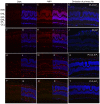Phosphoinositides: minor lipids make a major impact on photoreceptor cell functions
- PMID: 24964953
- PMCID: PMC4071336
- DOI: 10.1038/srep05463
Phosphoinositides: minor lipids make a major impact on photoreceptor cell functions
Abstract
Activation of the phosphoinositide (PI) cycle generates the second messengers that control various aspects of cellular signaling. We have previously shown that two PI cycle enzymes, type II phosphatidylinositol 5-phosphate 4-kinase (PIPK IIα) and phosphoinositide 3-kinase (PI3K), are activated through light stimulation. In our earlier studies, we measured enzyme activities, instead of directly measuring the products, due to lack of sensitive analytical techniques. Cells have very low levels of PIs, compared to other lipids, so special techniques and sensitive analytical instruments are necessary for their identification and quantification. There are also other considerations, such as different responses in different cell types, which may complicate quantification of PIs. For example, although light activated PIPK IIα, there was no increase in PI-4,5-P2 measured by liquid chromatography-mass spectrometry (LC/MS) This discrepancy is due to the heterogeneous nature of the retina, which is composed of various cell types. In this study, we examined PI generation in situ using immunohistochemistry with specific PI antibodies. PIs were generated in specific retinal cell layers, suggesting that analyzing PIs from the total retina by LC/MS underscores the significance. This suggests that PI-specific antibodies are useful tools to study the cell-specific regulation of PIs in the retina.
Figures







References
-
- Fruman D. A., Meyers R. E. & Cantley L. C. Phosphoinositide kinases. Annu. Rev. Biochem. 67, 481–507 (1998). - PubMed
-
- Martin T. F. Phosphoinositide lipids as signaling molecules: common themes for signal transduction, cytoskeletal regulation, and membrane trafficking. Annu. Rev. Cell Dev. Biol. 14, 231–264 (1998). - PubMed
-
- Streb H., Irvine R. F., Berridge M. J. & Schulz I. Release of Ca2+ from a nonmitochondrial intracellular store in pancreatic acinar cells by inositol-1,4,5-trisphosphate. Nature 306, 67–69 (1983). - PubMed
-
- Rameh L. E. & Cantley L. C. The role of phosphoinositide 3-kinase lipid products in cell function. J. Biol. Chem. 274, 8347–8350 (1999). - PubMed
Publication types
MeSH terms
Substances
Grants and funding
LinkOut - more resources
Full Text Sources
Other Literature Sources
Research Materials
Miscellaneous

